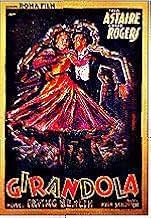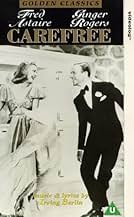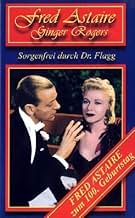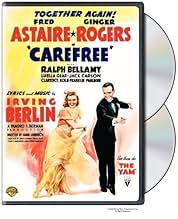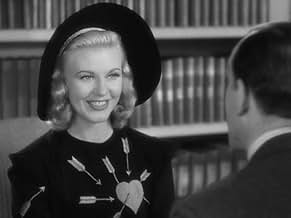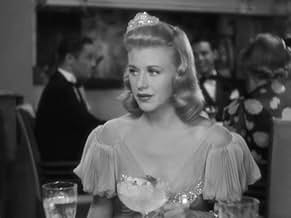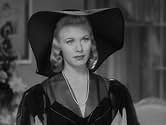NOTE IMDb
6,9/10
4,5 k
MA NOTE
Ajouter une intrigue dans votre langueA psychiatrist falls in love with the woman he's supposed to be nudging into marriage with someone else.A psychiatrist falls in love with the woman he's supposed to be nudging into marriage with someone else.A psychiatrist falls in love with the woman he's supposed to be nudging into marriage with someone else.
- Réalisation
- Scénario
- Casting principal
- Nommé pour 3 Oscars
- 3 victoires et 4 nominations au total
The Robert Mitchell Boy Choir
- Vocal Ensemble
- (scènes coupées)
- (as Robert B. Mitchell and his St. Brendan's Boys)
Harry A. Bailey
- Sponsor
- (non crédité)
Bobby Barber
- Minor Role
- (non crédité)
Cliff Bergere
- Minor Role
- (non crédité)
Ralph Brooks
- Country Club Guest
- (non crédité)
James P. Burtis
- Glass Truck Driver
- (non crédité)
Harry Campbell
- Minor Role
- (non crédité)
James Carlisle
- Country Club Guest
- (non crédité)
Charles Coleman
- Doorman
- (non crédité)
Avis à la une
Fred Astaire and Ginger Rogers star in this delightful romantic musical comedy with a twist on the usual Fred and Ginger plot. Though odd and short in the musical number department, this teasing romantic romp features some of their best dancing and good humor to boot. Ginger Rogers is nothing short of stunning in this picture and Mr. Astaire's feet never touch the ground. Definitely their most underrated film.
The upper-class Stephen Arden (Ralph Bellamy) brings his fiancée, the radio singer Amanda Cooper (Ginger Rogers), to be consulted by his friend, the psychoanalyst Dr. Tony Flagg (Fred Astaire), to improve their relationship. Amanda listens to the record made by Dr. Flagg about her and has an initial friction with the shrink. But sooner she falls in love with him and discloses her feelings to Dr. Flagg. He decides to hypnotize Amanda to loath him and love Stephen. However his subconscious makes him perceive that he also loves Amanda. But Stephen obtains a restrain order against his friend and he can not get close to Amanda to withdrawal his former hypnotic suggestion.
"Carefree" is a delightfully naive and adorable classic, with a silly story but wonderful dance numbers of the constant pair Fred Astaire and Ginger Rogers. Ginger "steals" the film not only dancing, but also with a funny performance. My vote is seven.
Title (Brazil): "Dance Comigo" ("Dance with Me")
"Carefree" is a delightfully naive and adorable classic, with a silly story but wonderful dance numbers of the constant pair Fred Astaire and Ginger Rogers. Ginger "steals" the film not only dancing, but also with a funny performance. My vote is seven.
Title (Brazil): "Dance Comigo" ("Dance with Me")
CAREFREE (RKO Radio, 1938), directed by Mark Sandrich, a screwball comedy set to music, reunites the song and dance team of Fred Astaire and Ginger Rogers for the eighth time in a sort of welcome change from their previous efforts: Astaire plays a doctor, psychiatrist by profession, rather than his usual lovesick American dancer, although the doctor in question DOES have a talent for dancing. Rogers, breaking away from sophisticated humor, makes her mark in broader comedy. She's been funny before, usually sassy with nifty comebacks, but this time in the dizzy-dame mode, but fortunately, not to the extreme.
The plot focuses on Stephen Arden (Ralph Bellamy), a witless attorney. He becomes drunk after his engagement to popular radio star, Amanda Cooper (Ginger Rogers), has been broken for the third time and stumbles to the Medical Foundation building to ask his good friend, Dr. Tony Flagg (Fred Astaire), a psychiatrist assisted by his white coated Connors (Jack Carson), to have Amanda "what's 'er name" analyzed. While waiting in his office, Amanda, accidentally stumbles upon Flagg's phonograph record, listening to a diagnosis about his last patient, closing with his comment about his next patient, Miss Cooper, being a "maladjusted woman." Upset, Amanda turns the tables around by sitting behind his desk and the doctor uncomfortably on the other end in a question and answer session. While bicycling in the park with Steven and her Aunt Cora (Luella Gaer), Amanda and Tony meet again, coming come to friendly terms. Agreeing to Tony's treatments, Amanda goes through a dinner special diet (lobster with mayonnaise and buttermilk) so to have her dreams analyzed, and hypnotism that turns to disaster when roaming the streets in a trance.
With plenty of comedy written into the screenplay, it's a wonder how dance numbers could fit into an overall "screwball" comedy, especially with a score by Irving Berlin. This is where CAREFREE stands apart from the other Astaire and Rogers films. The first number, "Since They Turned 'Loch Lamond' Into Swing" finds Astaire at a golf course accomplishing several things at the same time by playing the harmonica and tap dancing to a Scottish underscoring while teeing off several golf balls in rhythm, all to perfection without once missing his mark. There is no vocal to this number. "I Used to Be Color Blind" is very interesting mainly because it takes part as Rogers' dream dance, with Astaire, singing and dancing in slow motion. While "The Yam" sung by Ginger Rogers at the country club, is an upbeat number, followed by dancing with Astaire on wooden floors rather than the traditional glossy ones. It didn't become a memorable duet as "The Carioca," "The Continental" or "The Piccolino," but unlike these earlier dance numbers, which Fred and Ginger are the main focus, they invite dinner guests to join in with them. The final number, "Change Partners," a more appropriate title than "Carefree," is a beautiful love dance, or trance dance, where the hypnotized Rogers dances in a motionless manner with Astaire. While "Change Partners" is in slower tempo, it's one of the film's most memorable tune, it not, their most sentimental dance sequences. "Change Partners" earned an Academy Award nomination as Best Song.
Luella Gear, as Rogers' matron aunt, Cora, comes across as a middle-aged Kay Francis but speaking like Helen Broderick. Gear, in her movie debut, had very few films to her credit. She's reportedly best known for her role as Aunt Hortence in the stage version of THE GAY DIVORCE (1932) that starred Astaire. Ralph Bellamy, who by this time was usually type-cast as stuffy suitors, happens to be the most masculine of Rogers' rejected beaus thus far. His character, however, becomes very unlikable towards the second half, bogging down the story.
Rounding out the cast in smaller roles are Franklin Pangborn (Roland Hunter); and Hattie McDaniel (Hattie, the maid); and Kay Sutton (Miss Adams). Clarence Kolb takes support as the no-nonsense Judge Joe Travers, Stephen's friend who pleasure himself by telling corny jokes. Although credited, the Robert B. Mitchell and the St. Brendan's Boy Choir seem to have become victims of the editing process consider how they're nowhere to be seen, only heard on the soundtrack singing "Change Partners" near the film's close.
In spite of numerous pros and cons, CAREFREE ranks the team's most underrated film as shortest (83 minutes). It's occasionally funny in spots with imaginable, if not too successful, dance numbers. Other than CAREFREE being available on video cassette and DVD, and formerly found on American Movie Classics prior to 2001, it turns up occasionally (with close casting credits restored) on Turner Classic Movies. Next in the Astaire and Rogers series, THE STORY OF VERNON AND IRENE CASTLE (1939). (***)
The plot focuses on Stephen Arden (Ralph Bellamy), a witless attorney. He becomes drunk after his engagement to popular radio star, Amanda Cooper (Ginger Rogers), has been broken for the third time and stumbles to the Medical Foundation building to ask his good friend, Dr. Tony Flagg (Fred Astaire), a psychiatrist assisted by his white coated Connors (Jack Carson), to have Amanda "what's 'er name" analyzed. While waiting in his office, Amanda, accidentally stumbles upon Flagg's phonograph record, listening to a diagnosis about his last patient, closing with his comment about his next patient, Miss Cooper, being a "maladjusted woman." Upset, Amanda turns the tables around by sitting behind his desk and the doctor uncomfortably on the other end in a question and answer session. While bicycling in the park with Steven and her Aunt Cora (Luella Gaer), Amanda and Tony meet again, coming come to friendly terms. Agreeing to Tony's treatments, Amanda goes through a dinner special diet (lobster with mayonnaise and buttermilk) so to have her dreams analyzed, and hypnotism that turns to disaster when roaming the streets in a trance.
With plenty of comedy written into the screenplay, it's a wonder how dance numbers could fit into an overall "screwball" comedy, especially with a score by Irving Berlin. This is where CAREFREE stands apart from the other Astaire and Rogers films. The first number, "Since They Turned 'Loch Lamond' Into Swing" finds Astaire at a golf course accomplishing several things at the same time by playing the harmonica and tap dancing to a Scottish underscoring while teeing off several golf balls in rhythm, all to perfection without once missing his mark. There is no vocal to this number. "I Used to Be Color Blind" is very interesting mainly because it takes part as Rogers' dream dance, with Astaire, singing and dancing in slow motion. While "The Yam" sung by Ginger Rogers at the country club, is an upbeat number, followed by dancing with Astaire on wooden floors rather than the traditional glossy ones. It didn't become a memorable duet as "The Carioca," "The Continental" or "The Piccolino," but unlike these earlier dance numbers, which Fred and Ginger are the main focus, they invite dinner guests to join in with them. The final number, "Change Partners," a more appropriate title than "Carefree," is a beautiful love dance, or trance dance, where the hypnotized Rogers dances in a motionless manner with Astaire. While "Change Partners" is in slower tempo, it's one of the film's most memorable tune, it not, their most sentimental dance sequences. "Change Partners" earned an Academy Award nomination as Best Song.
Luella Gear, as Rogers' matron aunt, Cora, comes across as a middle-aged Kay Francis but speaking like Helen Broderick. Gear, in her movie debut, had very few films to her credit. She's reportedly best known for her role as Aunt Hortence in the stage version of THE GAY DIVORCE (1932) that starred Astaire. Ralph Bellamy, who by this time was usually type-cast as stuffy suitors, happens to be the most masculine of Rogers' rejected beaus thus far. His character, however, becomes very unlikable towards the second half, bogging down the story.
Rounding out the cast in smaller roles are Franklin Pangborn (Roland Hunter); and Hattie McDaniel (Hattie, the maid); and Kay Sutton (Miss Adams). Clarence Kolb takes support as the no-nonsense Judge Joe Travers, Stephen's friend who pleasure himself by telling corny jokes. Although credited, the Robert B. Mitchell and the St. Brendan's Boy Choir seem to have become victims of the editing process consider how they're nowhere to be seen, only heard on the soundtrack singing "Change Partners" near the film's close.
In spite of numerous pros and cons, CAREFREE ranks the team's most underrated film as shortest (83 minutes). It's occasionally funny in spots with imaginable, if not too successful, dance numbers. Other than CAREFREE being available on video cassette and DVD, and formerly found on American Movie Classics prior to 2001, it turns up occasionally (with close casting credits restored) on Turner Classic Movies. Next in the Astaire and Rogers series, THE STORY OF VERNON AND IRENE CASTLE (1939). (***)
Hilarious and very stylish, this spellbinding art moderne musical is a real experiment in RKO craftsmanship. Did you know the dream sequences to the song "I used to be color blind" were originally filmed in color but the release abandoned because RKO couldn't get the tech specs right and the cost was going to be too high for the budget already set. It was a great idea and today might have made CAREFREE a more enduring success as there is no color footage of them as a dancing pair until 1949 at MGM.. Apart from the snazzy look of the art direction, Ginger's fantastic 'hearts and arrows' outfit and big black bewitching hat and the RKO world of the stone and timber country club, the music here is just terrific. The swing antics of the golf club bagpipe sequence had one audience I saw it with in rapturous applause. But I defy anyone to stay seated during THE YAM as they wing and swing their way all over the BIG SET Country club. CAREFREE is just great.
In the eighth of ten screen appearances together, Fred Astaire and Ginger Rogers were firmly established as Hollywood's leading dancing pair. What is interesting about this 1938 entry is that it feels less like a musical and more like a screwball farce with musical interludes composed by Irving Berlin. The other less tangible aspect is that one can sense the two were growing in different directions at this particular juncture. While Astaire is still his debonair, nimble-footed self and as immaculate a dancer as ever there was on screen (watch his golfing solo for proof), Rogers seems to find surer footing as a crack comedy actress this time around. That's not to say they don't create magic when they dance. Indeed they do, an especially wonderful treat captured crisply on the newly released DVD, but you can somehow feel the beginning of the end.
Credited to no less than seven writers, the nonsensical plot focuses on singer Amanda Cooper, a radio star who has broken off her engagement three times to Stephen Arden, a rich bon vivant who spends an inordinate amount of time at the country club. Concerned about her flightiness but convinced that she is the one for him, he consults with his psychiatrist friend, Dr. Tony Flagg. Upon Stephen's insistence, Amanda goes to see Tony, and things immediately start off on the wrong foot when she overhears some of Tony's insensitive remarks about women on a dictaphone. Amanda and Tony eventually bury the hatchet over an accident-prone bike ride and become friends. You can probably figure out the rest of the complications that occur.
Even though Astaire acquits himself well as Tony (a rare role where he is not a professional entertainer) and Ralph Bellamy gamely plays yet another third-wheel role as Stephen, it is really Rogers who dominates the comedy scenes with her sharp timing and spirited manner. Moreover, the dance numbers don't disappoint with a lovely dream sequence set to "(I Used to Be) Colorblind" and a concluding romantic pas-de-deux cast under a hypnotic spell in "Change Partners". But my personal favorite is "The Yam", a jazzy, acrobatic number meant to replicate the late-thirties dance crazes. With Astaire bouncing Rogers on a series of cushiony chairs and then gracefully twirling her airborne over his table-affixed leg, this one may be my favorite of all their screen dances based on their sheer energy and athleticism.
For whatever reason, the supporting cast is not nearly as memorable as other Astaire-Rogers films at the time with Luella Gear looking a little too young as Amanda's Aunt Cora, Clarence Kolb as crabby Judge Travers and a young Jack Carson as Tony's helpful clinic assistant (doing a pretty decent Japanese accent over the phone). While the use of psychoanalysis must have been quite novel at the time, it feels rather clichéd now. Nonetheless, Astaire and Rogers still make magic regardless of the story contrivance. The 2006 DVD contains two vintage extras a twenty-minute, tap dancing short called "Public Jitterbug #1" about an outlaw jitterbug dancer, and a brief cartoon, "September in the Rain", where famous icons displayed on packaged foods of the day come to life.
Credited to no less than seven writers, the nonsensical plot focuses on singer Amanda Cooper, a radio star who has broken off her engagement three times to Stephen Arden, a rich bon vivant who spends an inordinate amount of time at the country club. Concerned about her flightiness but convinced that she is the one for him, he consults with his psychiatrist friend, Dr. Tony Flagg. Upon Stephen's insistence, Amanda goes to see Tony, and things immediately start off on the wrong foot when she overhears some of Tony's insensitive remarks about women on a dictaphone. Amanda and Tony eventually bury the hatchet over an accident-prone bike ride and become friends. You can probably figure out the rest of the complications that occur.
Even though Astaire acquits himself well as Tony (a rare role where he is not a professional entertainer) and Ralph Bellamy gamely plays yet another third-wheel role as Stephen, it is really Rogers who dominates the comedy scenes with her sharp timing and spirited manner. Moreover, the dance numbers don't disappoint with a lovely dream sequence set to "(I Used to Be) Colorblind" and a concluding romantic pas-de-deux cast under a hypnotic spell in "Change Partners". But my personal favorite is "The Yam", a jazzy, acrobatic number meant to replicate the late-thirties dance crazes. With Astaire bouncing Rogers on a series of cushiony chairs and then gracefully twirling her airborne over his table-affixed leg, this one may be my favorite of all their screen dances based on their sheer energy and athleticism.
For whatever reason, the supporting cast is not nearly as memorable as other Astaire-Rogers films at the time with Luella Gear looking a little too young as Amanda's Aunt Cora, Clarence Kolb as crabby Judge Travers and a young Jack Carson as Tony's helpful clinic assistant (doing a pretty decent Japanese accent over the phone). While the use of psychoanalysis must have been quite novel at the time, it feels rather clichéd now. Nonetheless, Astaire and Rogers still make magic regardless of the story contrivance. The 2006 DVD contains two vintage extras a twenty-minute, tap dancing short called "Public Jitterbug #1" about an outlaw jitterbug dancer, and a brief cartoon, "September in the Rain", where famous icons displayed on packaged foods of the day come to life.
Le saviez-vous
- AnecdotesThis was the first Fred Astaire-Ginger Rogers film to lose money on its initial release. It lost $68,000 (~ $1.48M in 2024) for RKO according to studio records.
- GaffesAs Amanda (Ginger Rogers) exits the taxicab and starts to cross the street for the theatre, you can see the reflection of the roof line behind her in the large piece of plate glass on the truck. On the roof line, you can see the rigging pipes for lights and other equipment showing it's a back lot set.
- Citations
Stephen Arden: [drunkenly] Oh, uh, could you give me a little information?
Doorman: Yes sir.
Stephen Arden: Thank you.
[walks away]
- Crédits fousDuring opening credits, a pair of hands finger-paints names, pauses, wipes them out, and writes the next set of names several times.
- ConnexionsFeatured in Fred Astaire: Puttin' on His Top Hat (1980)
- Bandes originalesSince They Turned Loch Lomond into Swing
(1938) (uncredited)
Music by Irving Berlin
Danced by Fred Astaire
Meilleurs choix
Connectez-vous pour évaluer et suivre la liste de favoris afin de recevoir des recommandations personnalisées
- How long is Carefree?Alimenté par Alexa
Détails
Box-office
- Budget
- 1 253 000 $US (estimé)
- Durée
- 1h 23min(83 min)
- Couleur
- Rapport de forme
- 1.37 : 1
Contribuer à cette page
Suggérer une modification ou ajouter du contenu manquant

